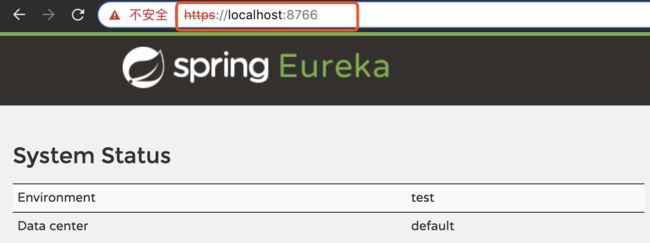上一篇主要说的是开启http basic认证,从安全角度来讲,基于base64编码,容易被抓包后破解,在公网中很不安全,本文详谈如何在eureka server和eureka client中开启https。
公共依赖pom文件
org.springframework.boot spring-boot-starter-parent 2.0.3.RELEASE UTF-8 UTF-8 1.8 Finchley.RELEASE org.springframework.cloud spring-cloud-dependencies ${spring-cloud.version} pom import
1、eureka server工程
1.1、eureka server工程pom:
org.springframework.cloud spring-cloud-starter-netflix-eureka-server org.springframework.boot spring-boot-maven-plugin
1.2、eureka server工程启动类:
import org.springframework.boot.SpringApplication; import org.springframework.boot.autoconfigure.SpringBootApplication; import org.springframework.cloud.netflix.eureka.server.EnableEurekaServer; @SpringBootApplication @EnableEurekaServer public class EurekaServerApplication { public static void main(String[] args) { SpringApplication.run(EurekaServerApplication.class, args); } }
1.3、生成证书
a、生成server工程的证书,使用命令行工具,执行下面的指令:
keytool -genkeypair -alias server -storetype PKCS12 -keyalg RSA -keysize 2048 -keystore server.p12 -validity 3650 输入密钥库口令: 再次输入新口令: 您的名字与姓氏是什么? [Unknown]: spring 您的组织单位名称是什么? [Unknown]: spring 您的组织名称是什么? [Unknown]: spring 您所在的城市或区域名称是什么? [Unknown]: spring 您所在的省/市/自治区名称是什么? [Unknown]: spring 该单位的双字母国家/地区代码是什么? [Unknown]: spring CN=spring, OU=spring, O=spring, L=spring, ST=spring, C=spring是否正确? [否]: y
b、同样的方式生成client工程证书,执行下面的指令:
keytool -genkeypair -alias client -storetype PKCS12 -keyalg RSA -keysize 2048 -keystore client.p12 -validity 3650
//。。。同样需要设置密码,回答上面的那些问题
c、分别导出2个p12证书,执行指令:
keytool -export -alias server -file server.crt --keystore server.p12 输入密钥库口令: 这里的密码是生成server证书时设置的密码 存储在文件中的证书
keytool -export -alias client -file client.crt --keystore client.p12 输入密钥库口令: 这里的密码是生成client证书时设置的密码 存储在文件中的证书
d、将server.crt文件导入client.p12证书中,使client端信任server的证书,执行如下指令
keytool -import -alias server -file server.crt -keystore client.p12 输入密钥库口令: 这里的密码是生成client证书密码,密码错误会提示如下信息: 【密码错误时提示的信息:keytool 错误: java.io.IOException: keystore password was incorrect】
所有者: CN=spring, OU=spring, O=spring, L=spring, ST=spring, C=spring 发布者: CN=spring, OU=spring, O=spring, L=spring, ST=spring, C=spring 序列号: 2b87a269 有效期为 Fri Oct 04 20:11:07 CST 2019 至 Mon Oct 01 20:11:07 CST 2029 证书指纹: MD5: EF:A3:6B:32:DE:8F:E4:34:46:E6:0D:48:B9:8F:B8:7E SHA1: AE:42:78:14:D8:6B:B2:E9:46:F4:76:E8:D9:D0:51:E0:3A:E6:C9:2E SHA256: 54:6D:93:7E:B3:D3:C4:49:87:84:9D:46:66:B1:B8:1B:95:5B:DC:05:9A:8A:A4:DF:43:E4:A7:A7:4A:81:F7:B0 签名算法名称: SHA256withRSA 主体公共密钥算法: 2048 位 RSA 密钥 版本: 3 扩展: #1: ObjectId: 2.5.29.14 Criticality=false SubjectKeyIdentifier [ KeyIdentifier [ 0000: 6C 1A E4 01 EB 84 0B C2 90 97 81 3D DB 0D C3 F1 l..........=.... 0010: 4A FB 2A F4 J.*. ] ] 是否信任此证书? [否]: y 证书已添加到密钥库中
e、将client.crt文件导入server.p12文件,使server服务信任client的证书,执行如下指令:
keytool -import -alias client -file client.crt -keystore server.p12 输入密钥库口令: 这里的密码是生成server证书密码 所有者: CN=cloud, OU=cloud, O=cloud, L=cloud, ST=cloud, C=cloud 发布者: CN=cloud, OU=cloud, O=cloud, L=cloud, ST=cloud, C=cloud 序列号: 6ea2a01 有效期为 Fri Oct 04 20:27:38 CST 2019 至 Mon Oct 01 20:27:38 CST 2029 证书指纹: MD5: E9:22:2C:8D:C4:08:27:AD:02:75:93:31:C2:17:35:8E SHA1: BB:B0:9A:3A:98:43:5E:02:FC:8A:BC:85:33:DD:82:4A:4E:DF:3A:5C SHA256: 20:96:61:27:D1:CA:55:E5:B6:0E:41:CA:BC:84:F8:8F:1F:D8:25:87:10:50:90:E3:BC:12:39:35:74:16:4A:B3 签名算法名称: SHA256withRSA 主体公共密钥算法: 2048 位 RSA 密钥 版本: 3 扩展: #1: ObjectId: 2.5.29.14 Criticality=false SubjectKeyIdentifier [ KeyIdentifier [ 0000: 91 E6 46 EF 4C 9E 88 B1 2F 63 12 4B 39 53 9D 32 ..F.L.../c.K9S.2 0010: EF 0F 42 F9 ..B. ] ] 是否信任此证书? [否]: y 证书已添加到密钥库中
1.4、将生成的server.p12、server.crt、client.crt三个文件放在eureka server工程resources目录下。
1.5、添加eureka server工程相关resources配置文件
application-https.yml:
server: port: 8766 ssl: enabled: true key-store: classpath:server.p12 key-store-password: hello2019 #生成server证书时设置的密码 key-store-type: PKCS12 key-alias: server eureka: instance: hostname: localhost securePort: ${server.port} securePortEnabled: true nonSecurePortEnabled: false homePageUrl: https://${eureka.instance.hostname}:${server.port}/ statusPageUrl: https://${eureka.instance.hostname}:${server.port}/ client: registerWithEureka: false fetchRegistry: false serviceUrl: defaultZone: https://${eureka.instance.hostname}:${server.port}/eureka/ server: waitTimeInMsWhenSyncEmpty: 0 enableSelfPreservation: false
application.yml:
spring:
profiles:
active: https
1.6、启动eureka server工程,执行指令:
mvn spring-boot:run -Dspring.profiles.active=https
访问:https://localhost:8766
由此看出确实使用的是https,不妨在试一下访问:http://localhost:8766
2、eureka client工程
2.1、client工程pom文件:
org.apache.httpcomponents httpclient 4.5.5 org.springframework.cloud spring-cloud-starter-netflix-eureka-client org.springframework.boot spring-boot-maven-plugin
2.2、client工程启动类:
import org.springframework.boot.SpringApplication; import org.springframework.boot.autoconfigure.SpringBootApplication; import org.springframework.cloud.netflix.eureka.EnableEurekaClient; @SpringBootApplication @EnableEurekaClient public class EurekaClientApplication { public static void main(String[] args) { SpringApplication.run(EurekaClientApplication.class, args); } }
2.2、client工程resources配置文件
先将client.crt、client.p12、server.crt三个文件放在client工程的resources目录下。
application.yml:
spring:
profiles:
active: https
application-https.yml:
server: port: 8081 spring: application: name: client1 eureka: client: securePortEnabled: true ssl: key-store: client.p12 key-store-password: hello2020 serviceUrl: defaultZone: https://localhost:8766/eureka/
这里没有指定整个应用实例启用https,仅仅是开启访问eureka server的https配置,自定义eureka.client.ssl.key-store和eureka.client.ssl.key-store-password两个属性,指定client访问server的sslContext配置,需要在代码里指定DiscoveryClient.DiscoveryClientOptionalArgs:
import com.netflix.discovery.DiscoveryClient; import com.netflix.discovery.shared.transport.jersey.EurekaJerseyClientImpl; import org.apache.http.ssl.SSLContextBuilder; import org.springframework.beans.factory.annotation.Value; import org.springframework.context.annotation.Bean; import org.springframework.context.annotation.Configuration; import org.springframework.context.annotation.Profile; import javax.net.ssl.SSLContext; import java.io.IOException; import java.security.KeyManagementException; import java.security.KeyStoreException; import java.security.NoSuchAlgorithmException; import java.security.cert.CertificateException; /** * 指定client访问server的sslContext配置 */ @Profile({"https"}) @Configuration public class EurekaHttpsClientConfig { @Value("${eureka.client.ssl.key-store}") String keyStoreFileName; @Value("${eureka.client.ssl.key-store-password}") String keyStorePassword; @Bean public DiscoveryClient.DiscoveryClientOptionalArgs discoveryClientOptionalArgs() throws CertificateException, NoSuchAlgorithmException, KeyStoreException, IOException, KeyManagementException { EurekaJerseyClientImpl.EurekaJerseyClientBuilder builder = new EurekaJerseyClientImpl.EurekaJerseyClientBuilder(); builder.withClientName("eureka-https-client"); SSLContext sslContext = new SSLContextBuilder() .loadTrustMaterial( this.getClass().getClassLoader().getResource(keyStoreFileName),keyStorePassword.toCharArray() ) .build(); builder.withCustomSSL(sslContext); builder.withMaxTotalConnections(10); builder.withMaxConnectionsPerHost(10); DiscoveryClient.DiscoveryClientOptionalArgs args = new DiscoveryClient.DiscoveryClientOptionalArgs(); args.setEurekaJerseyClient(builder.build()); return args; } }
2.3、执行指令,启动client工程:
mvn spring-boot:run -Dspring.profiles.active=https
访问https://localhost:8766/
可以看到client工程已经成功注册到了server服务上。


